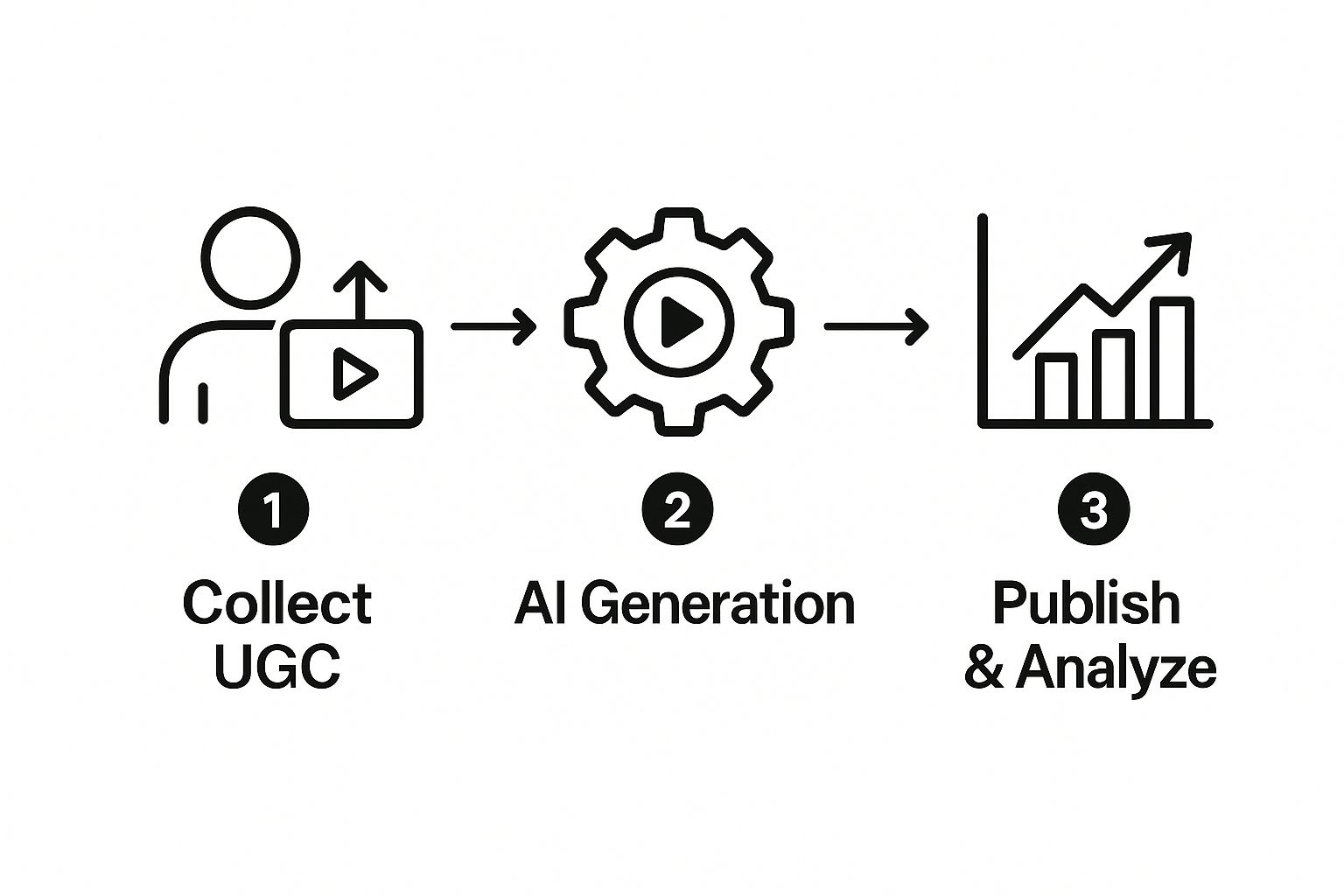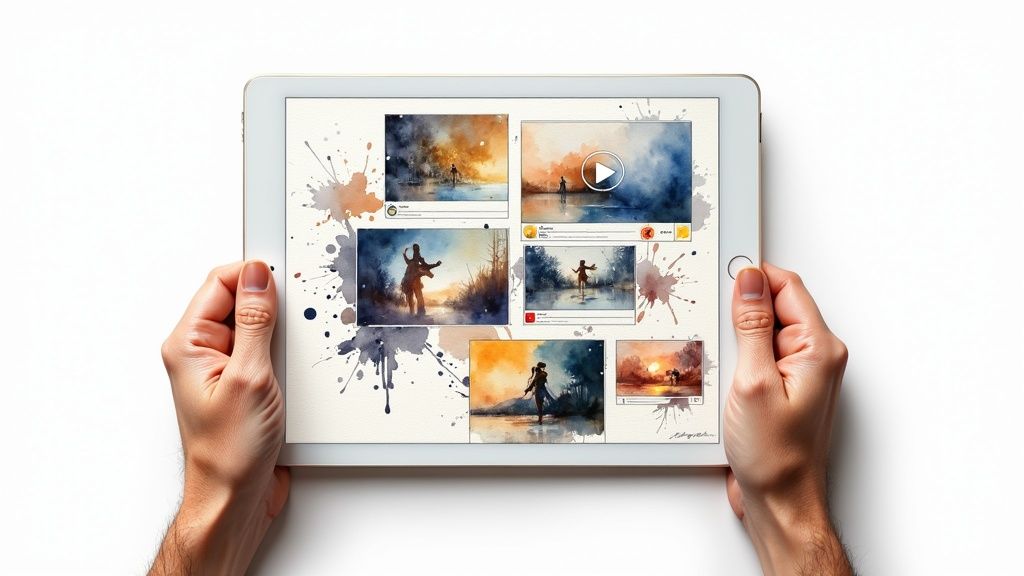In This Article
Subscribe to our newsletter
Understanding AI UGC Video Generators: Beyond The Hype
 This screenshot from Wikipedia's Artificial Intelligence page gives us a peek into the complex world of AI. Notice how different parts of AI, like machine learning and deep learning, are all connected. This is important because AI UGC video generators are built on these very principles, using these powerful technologies to make creative video content.
This screenshot from Wikipedia's Artificial Intelligence page gives us a peek into the complex world of AI. Notice how different parts of AI, like machine learning and deep learning, are all connected. This is important because AI UGC video generators are built on these very principles, using these powerful technologies to make creative video content.
Think of an AI UGC video generator not as a replacement for human creativity, but as a powerful assistant. Imagine having someone who can quickly take your basic ideas and turn them into polished videos, tirelessly working behind the scenes. This frees you up to focus on the important strategic details that make your brand unique. Plus, it lets you create way more content. Instead of spending hours editing, you can focus on brainstorming new ideas and connecting with your audience.
This technology is quickly gaining popularity. In 2023, the global market for AI video generators (including those for AI-powered user-generated content) was worth about USD 845 million. That's a lot, and it's only going to get bigger. By 2030, it's projected to reach USD 3.5 billion, growing at a rate of 23.5% each year. This shows a real need for tools that make video production faster and easier. Want to learn more about this growing market? Check out these AI video generation stats.
It's important to remember, though, that AI UGC video generators aren't magic. They need thoughtful input and a clear strategy to create truly engaging videos. The best results come from understanding what these tools can and can't do, using them to enhance your existing skills, not replace them. In the next sections, we'll dive into how these platforms actually work and explore the key features that separate the truly useful tools from the rest.
How AI UGC Video Generators Actually Work Behind The Scenes

This infographic gives us a simplified view of how an AI UGC video generator works. It breaks the process down into three main steps: gathering user-generated content, using AI to process and create the video, and finally, publishing and analyzing it. Notice how smoothly it goes from raw UGC to a polished video. That's the efficiency these platforms offer. This streamlined approach frees up creators to focus on strategy and audience engagement instead of getting bogged down in technical details.
So, what exactly is happening inside that AI "black box?" It's not magic. Instead, think machine learning driving a series of complex processes. Imagine the AI UGC video generator as a highly experienced video editor who has studied millions of successful videos. This "editor" knows exactly what grabs attention, from pacing and transitions to music and visual storytelling.
Deconstructing The AI Video Generation Process
The first thing the AI does is analyze your input. This could be anything from written text, images, or even short video clips. It's like handing your raw footage and creative brief to that expert editor. The AI then uses its deep understanding of video editing best practices to make decisions about visuals, transitions, and the overall structure.
Let's say you're making a product demo video. The AI might pick dynamic shots that highlight key features, add text overlays with specs, and choose background music that fits your brand. It's like having an intuitive editing assistant anticipating your needs and making smart creative decisions.
Next, the AI seamlessly blends audio with visuals, ensuring voiceovers, music, and sound effects are perfectly timed. This is where it feels like magic. The AI uses clever algorithms to analyze the audio and video data, automatically adjusting pacing and timing to tell a compelling story. Think of a human editor painstakingly syncing audio tracks with video footage, but at warp speed and with pinpoint accuracy.
Finally, the AI pieces everything together into a finished video. Titles, transitions, visual enhancements – it's all there. Just like a human editor would take your raw footage and transform it into a polished, professional-looking video, ready to share with the world. And the best part? This entire process, from start to finish, can take just minutes, significantly speeding up content creation.
To better understand the differences, let's look at a breakdown of the traditional video creation process compared to using an AI UGC generator.
AI Video Generation Process BreakdownStep-by-step comparison of traditional video creation vs AI-powered UGC generation
| Process Stage | Traditional Method | AI UGC Generator | Time Savings |
|---|---|---|---|
| Content Gathering | Manual collection and curation of footage | Automated aggregation of UGC | Significant - hours to minutes |
| Editing & Production | Manual editing, sound mixing, and visual effects | AI-powered editing, automated synchronization, and visual enhancements | Substantial - days to minutes |
| Review & Revisions | Multiple rounds of review and revisions | Quick preview and adjustments with AI-powered suggestions | Considerable - hours to minutes |
| Publishing & Distribution | Manual upload and distribution to platforms | Streamlined publishing and distribution options | Noticeable - hours to minutes |
| Analysis & Optimization | Manual analysis of performance metrics | AI-driven insights and A/B testing | Significant - hours to minutes |
This table clearly shows the significant time savings at each stage of the process when using an AI UGC video generator. The automation of previously manual tasks allows creators to focus on the creative aspects and strategy of their content.
Some AI UGC video generators even include automated A/B testing and sentiment analysis. This means the AI can further refine the video for maximum impact, allowing creators to optimize their content for different platforms and audiences, making sure each video resonates with the right viewers.
Essential Features That Separate Good Tools From Great Ones
Not all AI UGC video generators are created equal. Some are like basic slideshow creators, while others offer a full suite of creative tools. The difference? Their features and how well they meet your specific content needs. Think of it like comparing a simple point-and-shoot camera to a professional filmmaker's rig. Both capture video, but the level of control and the final product are vastly different. Let's explore the essential features that elevate an AI UGC video generator from simply "good" to truly "great."
Personalization and Branding
A truly powerful AI UGC video generator should allow for deep personalization. This goes beyond simply swapping out a logo or changing a font. Imagine dynamic templates that automatically incorporate your brand's colors, fonts, and logo into every video, ensuring a consistent visual identity. Does the generator offer pre-designed video Templates? Even better, some advanced tools can be trained on your existing content, learning your unique style to create videos that feel authentically yours.
Imagine having an AI assistant that understands your brand so well, it can create videos that perfectly reflect your voice. That's the power of personalization.
Intelligent Automation and Efficiency
Efficiency is a major draw of AI UGC video generators. Look for features like automated video editing, where the AI intelligently selects the best shots, adds smooth transitions, and syncs the audio – tasks that would normally take hours of manual work. Bulk video creation is another invaluable feature, allowing you to generate hundreds of variations quickly for A/B testing or personalized campaigns.
This is where the real time and cost savings come into play. In fact, 62% of companies using these tools report saving over 30% of their video production time, with average cost reductions around 25% globally (Market Research Future). These efficiencies free up content creators to focus on strategy and creative direction, not tedious editing.
Collaboration and Workflow Integration
For teams, seamless collaboration is key. Look for platforms with integrated workflow management, enabling easy sharing, review, and approval processes. This helps maintain brand consistency and streamlines content production. Check out our guide on the top 10 best AI video generators for 2025 for more on this.
Imagine a platform where marketing and sales teams can work together seamlessly on video projects, ensuring everyone is on the same page and quality remains high throughout. That’s the power of integrated workflows.
Real Success Stories: Where AI UGC Video Generators Shine

Imagine a small startup, barely making ends meet, needing to create impressive product demos. Traditionally, this meant hiring a film crew, expensive equipment, and hours of editing. A real budget breaker. But now, picture that same startup using an AI UGC video generator. Suddenly, high-quality demos are within reach, created quickly and affordably. This is the power these tools bring to the table.
This newfound ability to create professional videos without the usual costs changes everything for businesses of all sizes.
For example, e-commerce brands are now making thousands of product videos, seeing a big jump in sales compared to using static photos. Switching to dynamic video content engages customers more deeply, giving them richer information and a better online shopping experience. These AI tools let brands create personalized video content at scale, tailoring their message to specific customer groups for maximum impact. Want to learn more about creating videos from text? Check out this guide: Transforming Your Story with Text-to-Video Magic.
AI-generated UGC videos also help brands produce authentic, scalable, and cost-effective content, solving common UGC problems like inconsistent quality and slow production. Statistics show brands using UGC see 29% higher web conversions than those using traditional advertising. Learn more about how AI is changing UGC in e-commerce: The Revolution of AI UGC in E-commerce. This data clearly shows how powerful authentic, user-generated content is for customer engagement and sales.
Integrating With Existing Platforms
When considering AI UGC video generators, think about how they work with your current UGC platforms. Many brands, for instance, use Shopify UGC apps. This integration simplifies content creation, letting businesses easily add user-generated videos into their marketing plans. Connecting these tools helps companies expand their reach, build better customer relationships, and grow their business. This interconnected approach to content creation is a big step towards efficiency and scalability in digital marketing.
To better understand the impact across various sectors, let's examine some practical applications. The table below provides a detailed breakdown of how different industries are using AI UGC video generators.
Industry Applications and Use Cases
| Industry | Primary Use Case | Content Types | ROI Metrics |
|---|---|---|---|
| E-commerce | Product demonstrations, customer testimonials | Short-form videos, product reviews | Conversion rates, sales uplift |
| Education | Explainer videos, student project showcases | Tutorials, online courses | Course completion rates, student engagement |
| Travel & Hospitality | Destination highlights, virtual tours | Travel vlogs, hotel reviews | Booking rates, website traffic |
| Healthcare | Patient education, doctor testimonials | Informative videos, health tips | Patient satisfaction, appointment bookings |
| Technology | Software demos, product updates | Tutorial videos, webinars | Lead generation, product adoption |
As you can see, AI UGC video generators offer a wide range of applications across diverse industries. The key takeaway is that these tools provide a powerful way to enhance content creation, improve customer engagement, and ultimately drive business growth.
The Business Case: Why Smart Teams Are Making The Switch
The rise of AI UGC video generators marks a real change in how businesses create content. Think of it like the shift from film to digital cameras. It's not just a fad, it's a whole new way of working, offering clear strategic and financial benefits. Traditional video production is expensive, requiring investment in equipment, staff, and lots of time. AI UGC video generators present a more efficient and affordable path.
Democratizing Video Content Creation
One of the biggest advantages is how AI UGC video generators make high-quality video content accessible to everyone. Creating professional-looking videos used to demand specialized skills and big budgets. Now, even teams with limited resources and technical know-how can produce engaging video content. This empowers smaller businesses and individual creators to compete in a market where video is king. Many success stories demonstrate how teams expand their reach by cleverly using user-generated content. Resources like this guide on Leveraging User Generated Content offer practical advice.
Accelerating Testing and Iteration
AI UGC video generators also speed up testing and iteration. Imagine producing multiple versions of a video ad in just minutes, each one tweaked for a different audience. This allows for quick A/B testing and optimization, resulting in better campaign performance and higher conversion rates. This kind of agility just isn't possible with traditional video production.
Scaling Personalization Efforts
Personalization is another area where these tools excel. They can create personalized video messages at scale, speaking directly to individual customer needs and preferences. This deeper level of personalization can significantly boost customer engagement and build stronger brand loyalty. Connecting with customers in a personal way leads to more effective communication and strengthens brand building.
The global AI video generator market is set for massive growth. Projected to rise from USD 5.39 billion in 2025 to a whopping USD 62.89 billion by 2034, with a CAGR of over 20% per year. The AI video generator market report offers more detailed insights. This rapid expansion highlights the real impact these tools are having on businesses.
Restructuring Content Operations for the Future
Smart organizations are changing how they handle content creation and strategic planning to take advantage of AI. This means shifting resources away from traditional production and investing in AI-powered tools and training. This strategic shift sets these businesses up for success in a competitive market. It's not just about saving money; it's about opening up creative opportunities and transforming what's possible with the resources you already have. This allows teams to be more inventive and adapt to changing market needs, driving business growth and creating a competitive edge.
Choosing Your AI UGC Video Generator: A Practical Framework

This screenshot of OpenAI's website, a prominent player in AI, visually represents the increasing accessibility of these powerful tools. The focus on research and resources highlights the importance of understanding the technology behind AI-driven solutions like UGC video generators.
Picking the right AI UGC video generator from the many options available can be daunting. Think of it like choosing the right tool for a job. A hammer, a screwdriver, and a saw all have their uses, but you wouldn't use a hammer to tighten a screw. This section offers a practical guide to navigate these choices, looking beyond surface-level features and focusing on how these tools perform in practice. The AI-driven UGC video platform market, valued at USD 4.4 billion in 2022, is projected to reach a 29.4% CAGR by 2030. Learn more about this growth and its implications in this article about the impact of AI on the UGC video market. This significant growth highlights the importance of selecting the right tool for your needs.
Evaluating Real-World Performance
Choosing an AI UGC video generator requires looking past the marketing buzz. Concentrate on what real users are saying and compare how different tools perform side-by-side on actual tasks. This practical approach helps you understand which tools truly excel in different scenarios. For instance, short, catchy social media videos might benefit from a platform specializing in quick, engaging content. Longer, more polished product demo videos, however, would likely require a platform with more robust editing capabilities.
Consider these factors when picking the right tool for your video needs.
- Your typical video length: Are you creating short snippets or longer, in-depth pieces?
- Your desired level of polish: Are you aiming for quick and casual or highly professional?
- Your primary distribution platform: Where will your videos primarily live (e.g., social media, website)?
Key Factors to Consider
Several key factors will influence your decision-making process. A user-friendly interface minimizes the learning curve and encourages team adoption. Smooth integration capabilities with your existing tools ensure efficient workflows. Pricing structures should fit your budget and offer flexibility. Finally, reliable support quality gives you confidence in tackling any technical hiccups or needing guidance. For further insights on video creation, you might find this resource helpful: How to Convert an Article to Video: A Complete Guide for Publishers and Content Creators.
Here’s a quick recap of the essential factors:
- User-Friendliness: How easy is it for your team to learn and use the tool?
- Integration: Does it work well with the tools you already use?
- Pricing: Does the cost align with your budget and projected return on investment?
- Support: Is reliable help readily available when you need it?
Future-Proofing Your Choice
AI is a rapidly changing field. Picking a platform that can adapt to future developments is crucial. Look for a platform with a demonstrated commitment to innovation, regular updates, and the ability to integrate with emerging technologies. This proactive approach ensures your investment stays relevant as AI UGC video generation evolves.
Thinking long term will help you make a decision that not only works today but also sets you up for success tomorrow. Consider these factors:
- Innovation: Does the platform have a history of pushing the boundaries?
- Updates: Are new features and improvements released regularly?
- Emerging Tech Integration: Is the platform positioned to embrace future technological advancements?
Your First 30 Days: From Setup To Success
Ready to weave an AI UGC video generator into your content strategy? This isn't a rigid instruction manual, but more of a friendly guide, walking you through the first 30 days, from initial setup to seeing real results. We'll take a practical, step-by-step approach, starting small and building up. Think of it like learning a new musical instrument—you wouldn't start with a concerto, right? This approach minimizes risk and lets you quickly show the value it brings.
Week 1: Foundations and First Steps
First, pinpoint where an AI UGC video generator can make the biggest difference in your current content workflow. Where are the bottlenecks? Where could things be more efficient? Imagine automating product demos, creating quick social media snippets, or turning blog posts into engaging videos. Then, pick a pilot project – something manageable that delivers quick wins and builds team confidence. A good starting point might be creating a series of short product explainer videos. This lets you test the platform and get your team comfortable with its features.
Week 2: Building Momentum and Refining Processes
As your team gets the hang of things, refine your workflow. Document best practices, build templates for consistent branding, and set clear quality control guidelines. Think of it like fine-tuning a recipe – each tweak makes the final product even better. Also, get feedback from stakeholders and incorporate their suggestions. This collaborative approach ensures everyone feels involved and invested. For instance, team up with your marketing folks to create personalized video content for a specific audience segment.
Week 3: Scaling and Measuring Impact
Now it’s time to ramp things up. Start using the AI UGC video generator for more ambitious projects, using its automation for bulk video creation and personalized campaigns. At the same time, start tracking key metrics like engagement, conversion rates, and time saved. This data shows the return on your investment and justifies expanding its use further. Imagine generating multiple variations of a video ad for A/B testing, allowing for data-driven optimization.
Week 4: Optimization and Long-Term Strategy
With solid data in hand, optimize your processes for maximum efficiency. Refine your templates, tweak your workflows, and explore advanced features like sentiment analysis or A/B testing. Finally, start thinking long-term. How can the AI UGC video generator become a core part of your overall content strategy? How will it support your future goals? This forward-thinking approach ensures your investment keeps delivering value as your needs change.
Ready to see how AI can transform your content creation? Visit Aeon to discover how our platform can help you achieve your video content goals.






.jpg)